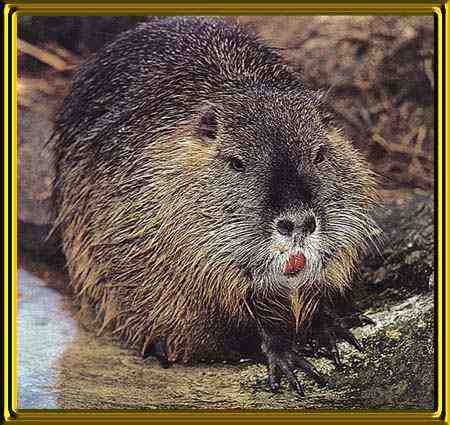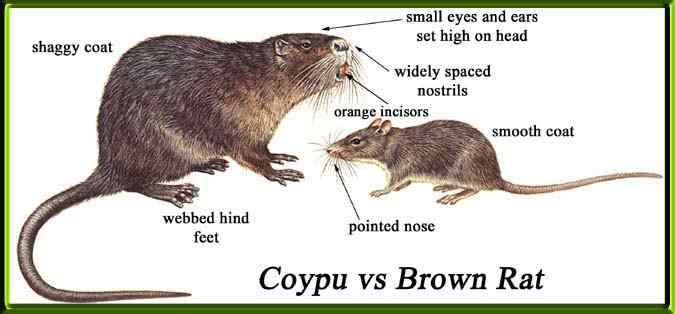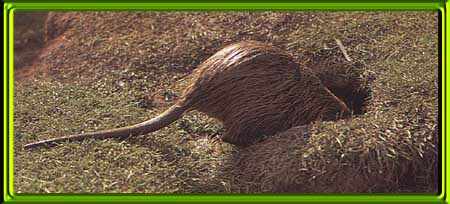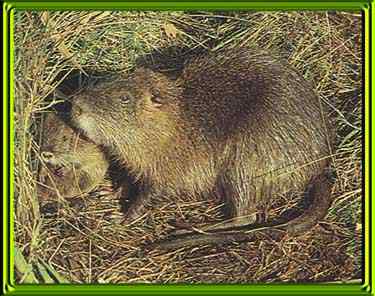
Myocastor
coypus
(Coypu)
(Swamp Beaver)
The Coypu is a large semi-aquatic rodent which is native to South America. It was introduced to the British Isles in 1929 when fur farms were set up in Sussex, Hampshire, Devon and Norfolk. The farms were sited mainly in lowland areas which are rich in rivers and streams. During the 1930's coypus escaped from captivity and despite repeated attempts to control them, they have adapted well to their new British habitat, breeding extremely successfully in the countryside of East Anglia. Today the Coypu, along with the Grey Squirrel, are a constant reminder of the folly of introducing foreign species into a new country without fully considering the consequences.Superficially the Coypu and the Brown Rat are rather similar in appearance, hardly surprising as they are both rodents. But the blunt square shape of the coypu's muzzle and it's webbed feet clearly distinguish it, not to mention it's size. In fact it is one of the largest rodents in the world exceeded only by the South American Capybara (more about that later). The picture below highlights some of the differences:
Lets have a look at some biology:
Size: The Coypu is about 1 metre (39 inches) in length from the end of it's muzzle to the tip of it's round scaly tail. The tail alone accounts for about one third of it's length. It has short rounded ears, and small eyes that are set high on the head (like those of a beaver) so that it can see clearly whilst swimming.
Weight: Adult males weigh about 7kg (15.5lbs) though some have known to reach 9kgs with the female about 1kg lighter.
Colour: The coypu's fur is specially adapted to keep it warm and dry in winter. Long, coarse guard hairs conceal and protect the soft velvety under fur. This under fur, known as nutria (Spanish for otter) in the fur trade, is the reason why the coypu was bred in this country. The general colour of the coypu's guard hairs is dark reddish or yellowish brown, masking the slate grey nutria. The tip of its muzzle and chin have white hairs and whiskers.
Breeding Season: Breeding is continuous throughout the year.
Gestation Period: This lasts for four and a half months.
Number of litters/Year: Working out the sums...only two.
No of young/litter: This is usually 2 - 9 per litter.
Food: This animal eats plants, including; grasses, sedges, reeds, water parsnip, reed -mace and even water lilies.
Predators: The young are taken by foxes, stoats, dogs etc.
Distribution: East Anglia.
One sign that coypus are about is their burrows. These are often made in ditches or soak-dykes that lie behind many of the raised banks in the Norfolk Broads, and sometimes extend for 5 metres or more. The burrow entrance is usually at river level and there may be more than one exit, the first leading onto the land and others leading back into the water. Coypus usually emerge from their burrows and become active just before sunset, returning underground again just before sunrise. In Britain they do feed during the day which is not the case in S. America. Within their home range the establish continuous runways through the vegetation on which they feed, eventually circling back to the water again - still under cover of the vegetation. On land they move slowly, with a crouching gait. But if disturbed they will bound away rapidly.
The picture above shows mum and baby for, like rabbits, coypu are prolific breeders. Their gestation period however is long for a rodent. From above it lasts for four and a half months, so just two litters a year are produced. Each litter consists of from two to nine young which are born fully furred and with their eyes open, a distinct advantage. They can move about within a few hours of birth. Longer gestation times in the animal kingdom usually mean that the young are more prepared to face the world when they are born. This is not the case with a human because our systems are more complicated and also human babies need the time with their parents to learn as they grow and to program the brain.
The mother coypus nipples are situated high on the sides of her body so the young can ride on her back and suckle while she is in the water. On land they feed on either side of their mother as she lies on her stomach. The young are weaned after seven or eight weeks, but mature at different times, depending on sex. The females are sexually mature when three to five months and the males when five to seven months old.
The adults have only man to fear, or sometimes dogs, the young can fall prey to foxes, weasels, stoats, otters, brown rats, dogs, owls, herons and hawks. Similarly, although a cold winter may take a heavy toll of young coypus - they die of starvation and exposure - nearly all of the adults survive. The population is reduced or contained because the females abort their litters in a severe winter; after losing a litter in this way a female will not bear young again until the following June or July.I have since been informed by:
Paul Cantwell
Wildlife Management Adviser
Department for Environment, Food & Rural Affairs (DEFRA)
Rural Development Service (RDS)"That MAFF as it was then (which has now been superseded by DEFRA) were successful in eradicating East Anglia of Coypu in December 1989. There have been no confirmed reports of Coypu in the Wild since that time".
Sorry about that folks...but you never know there maybe one skulking around somewhere..


